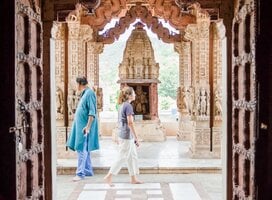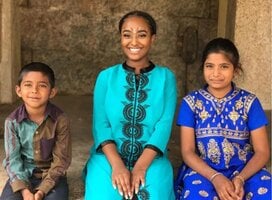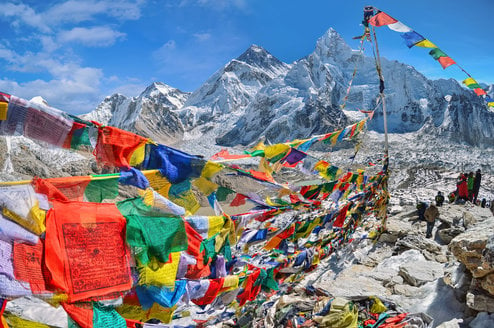High School Abroad Programs in India
Beautiful temples, yoga, Himalayan Mountains, the Ganges River, and traditions that date back 5 millennia have been inspiring students and travelers alike to venture to India. If you want to spend high school abroad in India, you're in for an adventure.
Spend a year in a direct exchange program in Varanasi, Delhi, or Dharamsala while living with a host family to learn more about spirituality and Indian culture. Have a meaningful summer volunteering in wildlife conservation, with public health NGOs, or at a low-income school in Bangalore, Chennai, or Kochi. Art lovers can even embark on a short photography expedition through the mountains.
India is great for students who are interested in religion, Asian Studies, the arts and music, learning Hindi, and want to live somewhere where the culture differs greatly from their own.
Students who want to spend time in India while they're in high school can choose from:
- Study Abroad
- Volunteer
- Summer Programs
- Teen Travel
Study Abroad
Spend a semester, year, or gap year in India participating in an exchange program, where you'll take classes alongside Indian students while living with a host family. Students will need to pick one of the following academic streams: engineering, medical, commerce, or arts. In addition to these streams, students will also get to take two electives that revolve around Indian tradition, including music or culinary arts, as well as a language course, either Hindi or a local dialect.
Volunteer
Volunteer programs take place over the summer and there are plenty of options to meet your interests. Students interested in education can spend their time teaching English to children. Environmental lovers can work with local organizations on conversation, ecological, and wildlife efforts. Students interested in public health can work on community development projects, such as clean water supply and construction efforts.
Summer Programs
Embark on a two week to three-month immersion journey in India, while you practice your language skills and learn more about Indian tradition. Many students will get to live with a host family while others will share a volunteer or guest house together. The summer programs are designed to give students different lectures, workshops, and volunteer opportunities to really connect with their surrounding communities.
Teen Travel
There are many programs that take students through different parts of India. If you're interested in learning about Hinduism and Indian culture, you can choose a program that takes you on the religious and spiritual pilgrimage. From the Himalayan Mountains, the Indus River Valley, gnats in Varanasi, and religious ruins in Delhi, you'll get to experience it all. Students interested in seeing other parts of this region can enroll in a traveling program that will also take them to Nepal and Sri Lanka.
Popular Cities
India is a huge country, with vast differences in landscape. Depending on your preference, you can choose a program in a city, or in a more remote village. Students who want to live in a city can choose from Varanasi, alongside the Ganges, Delhi, or Bangalore. Nature lovers can attend a program in Kerala along India's tropical coast, or Dharamsala, a largely Tibetan influenced city in the mountains. These are just a few of the many program location options available to students.
Visas
All travelers must have a valid passport and visa prior to arriving in India, according to the US Department of State. Students there for short-term programs that are 30 or fewer days will need to apply for an electronic travel authorization in place of a visa. Program providers will assist students with this process.
Housing
The majority of students will be placed with a host family during their time abroad in India. This is a great way for them to learn more about Indian culture, through family relationships, food, and hospitality during traditions and holidays. Students who do shorter programs will likely stay in a guest house for students, hostels, or in a tent while camping in the Himalayas.
Costs
The cost of each program varies by program provider and duration. Summer, volunteer, and teen travel programs last between one week to three months and range between $520-$9,335. Year-long programs cost about $15,500, and semester programs cost between $9,990- $13,995.
The official currency in India is the Rupees (Rs) and $1 USD is equivalent to 66.48 RS. You could get an all you can eat meal for $2-$5 at a budget restaurant. Midrange and fancy meals in cities can cost between $6-$20. Most vendors only take small change, so make sure to break down your bigger bills if you can.
Cultural Etiquette
Respect is an essential component of everyday life in India, especially with regards to your elders, including your host family, study abroad staff, and anyone else you come into contact with while you are abroad.
Academics are also very important in India. Host families expect you to be studying or practicing music or an art in your free time. Your academics come first, and Indian host families will put a big emphasis on that.
Contrary to in the United States, teenagers in India do not have a very big social life. Dating or showing sign of public affection are also not widely accepted, and curfew is enforced.
Packing Tips
People in India dress very modestly, and always wear appropriate clothing that isn't tight or revealing. Here's what we recommend that you pack:
- Shirts that cover your shoulders and don't droop beneath your collar bone
- A few pairs of pants, or long skirts for women (nothing that cuts off above the knee)
- Scarves, for when you need an extra layer.
- A sweater
- Flip flops
- Sneakers
- Type D power plug with three pins, 220V-240V
- A flashlight or headlamp
Vaccinations
Prior to entering India, it is recommended that travelers get vaccinated for Japanese encephalitis, Hepatitis A and B, Tuberculosis, Cholera, Meningococcal, Diphtheria, Rabies, and Typhoid according to The Travel Vaccination Companion.
Food
Cuisine is a quintessential part of Indian culture and life. Meals are usually cooked in large quantities so many people could enjoy dinner together. Rich in spice, Indian food is extremely flavorful and savory. Here are 50 Famous Indian Food Dishes to get your tastebuds excited about spending time abroad.
Safety
India is generally a very safe place, with the exception of the catcalling of women and petty theft. Females are advised to take caution by being aware of their surroundings, and to travel in groups when possible. As a general rule of thumb, all travelers should be aware of pickpocketing, especially in touristy locations. It's advised to wear a money belt under your clothing, and to make copies of your passport and credit cards.












